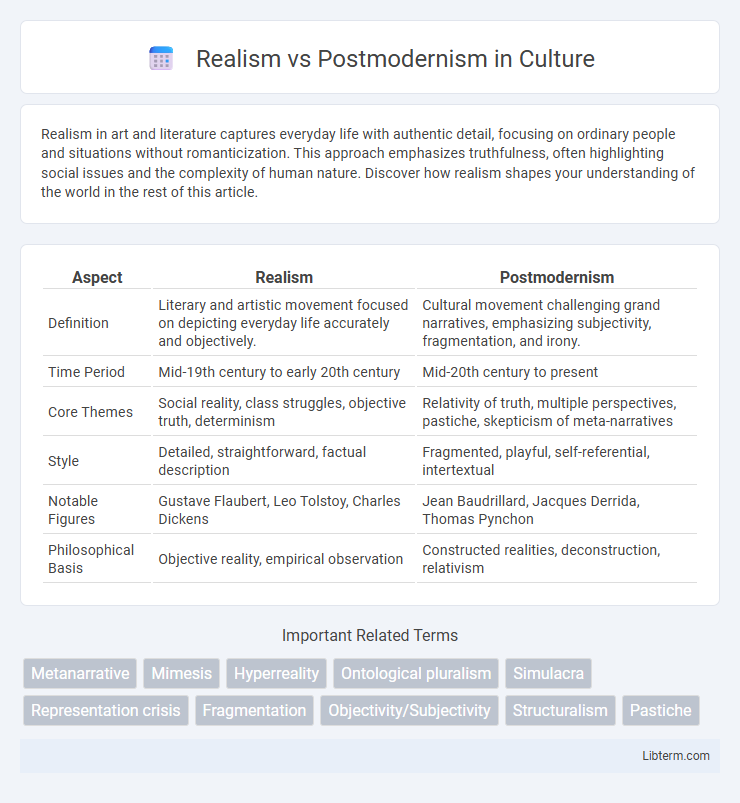Realism in art and literature captures everyday life with authentic detail, focusing on ordinary people and situations without romanticization. This approach emphasizes truthfulness, often highlighting social issues and the complexity of human nature. Discover how realism shapes your understanding of the world in the rest of this article.
Table of Comparison
| Aspect | Realism | Postmodernism |
|---|---|---|
| Definition | Literary and artistic movement focused on depicting everyday life accurately and objectively. | Cultural movement challenging grand narratives, emphasizing subjectivity, fragmentation, and irony. |
| Time Period | Mid-19th century to early 20th century | Mid-20th century to present |
| Core Themes | Social reality, class struggles, objective truth, determinism | Relativity of truth, multiple perspectives, pastiche, skepticism of meta-narratives |
| Style | Detailed, straightforward, factual description | Fragmented, playful, self-referential, intertextual |
| Notable Figures | Gustave Flaubert, Leo Tolstoy, Charles Dickens | Jean Baudrillard, Jacques Derrida, Thomas Pynchon |
| Philosophical Basis | Objective reality, empirical observation | Constructed realities, deconstruction, relativism |
Introduction to Realism and Postmodernism
Realism emphasizes objective representation of reality, portraying everyday life and society with accurate detail and an underlying belief in absolute truths. Postmodernism challenges these notions by promoting subjective interpretations, skepticism toward grand narratives, and recognition of fragmented identities and pluralistic meanings. The contrast highlights Realism's commitment to factual consistency against Postmodernism's focus on relativism and deconstruction of established truths.
Defining Realism: Core Principles
Realism emphasizes objective representation of reality through detailed, accurate depictions of everyday life, focusing on plausible events and characters grounded in social contexts. Core principles include the portrayal of life without idealization or romantic subjectivity, emphasizing cause-and-effect relationships and social determinism. This approach contrasts with Postmodernism's skepticism toward grand narratives and objective truths, prioritizing fragmented perspectives and metafictional techniques.
Understanding Postmodernism: Key Concepts
Postmodernism challenges the objective truths upheld by Realism, emphasizing relativism, hyperreality, and the deconstruction of meta-narratives. Central concepts include irony, pastiche, and fragmentation, which question established structures and meanings in literature, art, and philosophy. This worldview highlights the fluidity of identity and the instability of language, contrasting with Realism's focus on depicting an external, knowable reality.
Historical Contexts: Emergence and Evolution
Realism emerged in the mid-19th century as a reaction to Romanticism, emphasizing objective representation of everyday life and social realities during industrialization and political upheaval. Postmodernism arose in the mid-20th century amidst post-World War II disillusionment, challenging grand narratives and embracing fragmentation, irony, and pluralism in response to modernist ideals. Both movements reflect distinct historical contexts shaping their philosophies and artistic expressions through cultural, social, and technological transformations.
Major Differences Between Realism and Postmodernism
Realism emphasizes objective reality and detailed depiction of everyday life, prioritizing truth and consistency in narrative structure. Postmodernism challenges these notions by embracing subjectivity, fragmentation, and skepticism towards grand narratives and absolute truths. The contrast lies in realism's commitment to representation of a coherent world versus postmodernism's focus on plurality, ambiguity, and the deconstruction of meaning.
Representations of Truth and Reality
Realism asserts that truth and reality exist independently of perception, emphasizing objective representation through accurate, detailed depictions of the external world. Postmodernism challenges this notion by arguing that truth and reality are socially constructed, fragmented, and subjective, often mediated by language, culture, and power structures. Whereas Realism seeks coherence and universality, Postmodernism embraces ambiguity and multiple perspectives, destabilizing fixed meanings and questioning the possibility of absolute truth.
Influential Thinkers and Works
Realism is epitomized by influential thinkers like Emile Zola and Gustave Courbet, who emphasized objective representation and social realities through works such as Zola's novel "Germinal" and Courbet's painting "The Stone Breakers." Postmodernism, represented by figures like Jean-Francois Lyotard and Jacques Derrida, challenges grand narratives and embraces fragmentation, as seen in Lyotard's "The Postmodern Condition" and Derrida's development of deconstruction. These foundational texts and theorists shape the core philosophical divisions between objective truth in Realism and skepticism toward meta-narratives in Postmodernism.
Impact on Literature and the Arts
Realism transformed literature and the arts by emphasizing accurate, detailed depictions of everyday life and social conditions, influencing novelists like Gustave Flaubert and artists such as Gustave Courbet. Postmodernism challenged traditional narratives and artistic conventions through fragmentation, pastiche, and metafiction, evident in the works of authors like Thomas Pynchon and visual artists like Jeff Koons. The shift from Realism's objective representation to Postmodernism's skepticism toward grand narratives reshaped creative expression and critical theory in contemporary culture.
Critiques and Controversies
Realism faces critiques for oversimplifying complex social dynamics and ignoring subjective experiences, while Postmodernism is often criticized for its skepticism towards grand narratives and the potential relativism that can undermine objective truth. The controversy between the two centers on the balance between representing reality accurately and acknowledging the fragmented, constructed nature of knowledge. Debates highlight concerns over Realism's perceived rigidity versus Postmodernism's potential to foster nihilism or intellectual paralysis.
Conclusion: The Ongoing Debate
Realism emphasizes objective truth and stable meaning in literature and art, while Postmodernism challenges these notions with skepticism, embracing ambiguity and fragmented narratives. The ongoing debate centers on the relevance of universal truths versus subjective experiences in interpreting reality. Contemporary discourse continues to explore how both approaches shape cultural understanding and influence creative expression.
Realism Infographic

 libterm.com
libterm.com